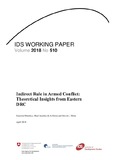| dc.contributor.author | Marchais, Gauthier | |
| dc.contributor.author | Sanchez de la Sierra, Raul | |
| dc.contributor.author | Henn, Soeren J. | |
| dc.coverage.spatial | Democratic Republic of the Congo | en |
| dc.date.accessioned | 2018-04-05T14:43:04Z | |
| dc.date.available | 2018-04-05T14:43:04Z | |
| dc.date.issued | 2018-04 | |
| dc.identifier.citation | Marchais, G.; Sanchez de la Sierra, R. and Henn, S.J. (2018) Indirect Rule in Armed Conflict: Theoretical Insights from Eastern DRC, IDS Working Paper 510, Brighton: IDS | en |
| dc.identifier.isbn | 978-1-78118-437-0 | |
| dc.identifier.issn | 2040-0209 | |
| dc.identifier.uri | https://opendocs.ids.ac.uk/opendocs/handle/20.500.12413/13610 | |
| dc.description.abstract | Recent literature has shown that the study of armed conflict can be highly informative to understand processes of state-building. One of the fundamental choices that states or other military actors face when occupying new territories and populations is whether to administer them by developing novel administrations (direct rule), or by devolving rule to pre-existing local authorities (indirect rule). The literature on the political and economic legacies of colonial rule has shown that this choice can have far-reaching consequences in terms of state capacity and legitimacy, affecting long-term development trajectories. Yet the conditions under which indirect rule emerged in the colonial period are very difficult to observe and analyse. Building on the analogy between armed factions in contemporary conflict settings and states in the making, this paper explores the conditions under which indirect rule emerges in contexts of armed conflict, and the consequences that this governance arrangement has on local governance institutions and legitimacy.
The paper adopts a historical and qualitative perspective, building on fieldwork and interviews carried out in the eastern Democratic Republic of the Congo (DRC). It provides a theoretical discussion of the strengths and limitations of the comparison between armed factions and proto-states, and develops novel analytical tools to understand ‘indirect rule’ governance arrangements by armed factions. The paper is a theoretical and qualitative companion to a separate paper based on a quantitative analysis of indirect rule (Sanchez de la Sierra, Henn and Marchais 2017). Importantly, this is an early draft of this paper, as its empirical section will be completed with additional qualitative fieldwork to be carried out in 2018, and the paper adjusted following the results of the quantitative study. | en |
| dc.description.sponsorship | Swiss Agency for Development and Cooperation | en |
| dc.language.iso | en | en |
| dc.publisher | IDS | en |
| dc.relation.ispartofseries | IDS Working Paper;510 | |
| dc.rights | All rights reserved. Reproduction, copy, transmission, or translation of any part of this publication may be made only under the following conditions:
• with the prior permission of the publisher; or
• with a licence from the Copyright Licensing Agency Ltd., 90 Tottenham Court Road, London W1P 9HE, UK,
or from another national licensing agency; or
• under the terms set out below.
This publication is copyright, but may be reproduced by any method without fee for teaching or nonprofit purposes, but not for resale. Formal permission is required for all such uses, but normally will be granted immediately. For copying in any other circumstances, or for re-use in other publications, or for translation or adaptation, prior written permission must be obtained from the publisher and a fee may be payable. | en |
| dc.rights.uri | http://www.ids.ac.uk/files/dmfile/IDSOpenDocsStandardTermsOfUse.pdf | en |
| dc.subject | Governance | en |
| dc.subject | Security and Conflict | en |
| dc.title | Indirect Rule in Armed Conflict: Theoretical Insights from Eastern DRC | en |
| dc.type | IDS Working Paper | en |
| dc.rights.holder | Institute of Development Studies and Swiss Agency for Development and Cooperation | en |
| dc.identifier.team | Governance | en |
| rioxxterms.funder | Default funder | en |
| rioxxterms.identifier.project | Default project | en |
| rioxxterms.version | VoR | en |
| rioxxterms.funder.project | 9ce4e4dc-26e9-4d78-96e9-15e4dcac0642 | en |


